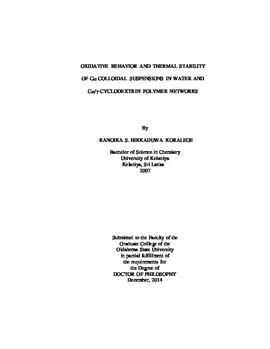| dc.contributor.advisor | Ausman, Kevin Douglas | |
| dc.contributor.author | Hikkaduwa Koralege, Rangika | |
| dc.date.accessioned | 2016-01-20T15:44:36Z | |
| dc.date.available | 2016-01-20T15:44:36Z | |
| dc.date.issued | 2014-12 | |
| dc.identifier.uri | https://hdl.handle.net/11244/25661 | |
| dc.description.abstract | Since its discovery in 1985, buckminsterfullerene (C60) has been extensively studied due to its unique properties and it's now being produced in multi-ton quantities. The ability to form stable aqueous C60 colloids (known as nano-C60 or nC60) and the availability of these in natural systems at environmentally-relevant concentrations led to significant interest concerning the environmental health and safety of these colloidal aggregates. Addressing two issues with regard to this material's environmental health and safety concerns we have looked at the oxidative mechanism of these nC60 colloidal aggregates and their thermal stability. For making accurate kinetics and measurements on oxidation caused by aqueous-nC60 colloidal dispersions, we have developed experimental methods utilizing dihydrorhodamine 123 (DHR123) as a sacrificial probe molecule to monitor oxidation by fluorescence spectroscopy and kinetic models to explain observed oxidation. Evaluation of the oxidative behavior of fullerene colloids has been determined using the oxidation rate as a function of nC60 concentration, nC60 surface area, number of colloidal particles and C60O content, operating where necessary under inert atmosphere and oxygen rich conditions. The effect of temperature on these colloids plays a significant role in both their synthesis and reactivity. Given that the colloids are mainly composed of C60 and C60O, C60O might play a significant role in stabilizing the colloid, hence increasing the temperature might cause thermally-activated reactions with C60O. Thermal stability of these colloids prepared by all four primary nC60 synthesis methods has been investigated. Incorporation of C60 into polymers is of potential interest for applications, for sequestration to address potential environmental health and safety issues, and as a component in novel architectures. A new composite material was developed by encapsulating C60 into cross-linked polymer network formed by y-cyclodextrin. A simple synthesis route to achieve composite membranes of intercalated C60 in the polymer network is presented. | |
| dc.format | application/pdf | |
| dc.language | en_US | |
| dc.rights | Copyright is held by the author who has granted the Oklahoma State University Library the non-exclusive right to share this material in its institutional repository. Contact Digital Library Services at lib-dls@okstate.edu or 405-744-9161 for the permission policy on the use, reproduction or distribution of this material. | |
| dc.title | Oxidative behavior and thermal stability of C60 colloidal suspensions in water and C60/gamma-cyclodextrin polymer networks | |
| dc.contributor.committeeMember | Blum, Frank D. | |
| dc.contributor.committeeMember | White, Jeffery L. | |
| dc.contributor.committeeMember | Berlin, Kenneth Darrell | |
| dc.contributor.committeeMember | Pope, Carey N. | |
| osu.filename | HikkaduwaKoralege_okstate_0664D_13759.pdf | |
| osu.accesstype | Open Access | |
| dc.type.genre | Dissertation | |
| dc.type.material | Text | |
| thesis.degree.discipline | Chemistry | |
| thesis.degree.grantor | Oklahoma State University | |
